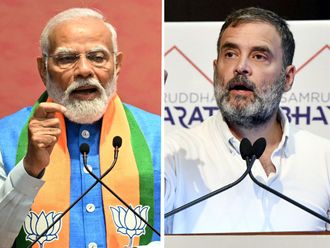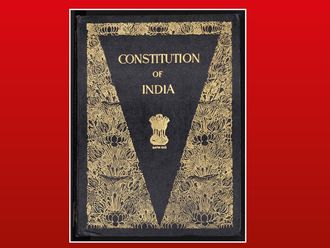
In India, caste is a highly emotive political word. There is a reason why Indians get excited when asked, jaat kaun si hai (what’s your caste)?
The tyranny of caste structure in India means that all Indian Hindus are born with a caste tag. Another matter, one can reject it later.
This division through castes has evolved on the basis of occupations but over the centuries it ended up in dehumanising few communities.
In the caste pyramid, at the very bottom lies the schedule caste, known as Dalits and schedule tribe called adivasis. There is a reservation of 15% and 7.5% respectively for them under affirmative action of the Indian constitution.
India’s intermediary classes, also known as Other Backward Classes, form the biggest chunk in the middle, having a reservation of 27% in government jobs. As economic deprivation increased this class felt left-out in the growth curve.
Indian society is fast modernising for several decades now. With growing urbanisation, caste identity is fading in some pockets - in bits and pieces.
Also, Rashtriya Swayamsevak Sangh’s (RSS) larger Hindu nationalist identity assertion project has helped blur caste identity.
But India’s caste matrix, by and large, remains the weapon of mass politics and quite hurtful in many ways.
There is no doubt that one of the biggest regrets of Prime Minister Narendra Modi’s political career will be that he couldn’t change the ground rules of electoral politics, where caste identities of the candidates are the main criteria of their selection.
The Mandal impact
Modi did try in Gujarat to break the status quo of the caste-grip in politics but with limited success.
Just imagine how strange it sounds: Indians are driven by caste politics but there is no official census data presenting empirical evidence of the exact population of OBCs.
The last all-castes-data was published in 1931. In the 90s the Mandal commission gave a tentative estimate that OBCs constitute 52% of India’s population.
Since the implementation of the Mandal report, India has vastly changed. The Brahminical dominance was challenged for the first time on a large scale in states like UP, Bihar among others.
The unthinkable happened when the oppressed intermediary classes got raw political power merely on the basis of their caste identity.
In Tamil Nadu, a pioneer in backward politics, the impact was so deep that many Tamil Brahmins rushed to apply for American visas. With power in the hands of non-Brahmins, there were changes in the societal discourse, university debates, political vocabulary, aesthetics, architecture, designs.
The Mandal era of 90s is waning as the leaders, leading the non-Brahmin parties, have lost the plot now due to various kinds of corruptions and also due to the BJP’s aggressive electoral politics to assert the Hindu identity.
The complexity of caste
India’s non-Brahminical classes want to relaunch Mandal politics by demanding the caste census. The optimist OBC leaders think the new increased OBC numbers will force government to remove the legal cap on 50% reservation. That’s the crux of the issue.
If the reservation in jobs and education — in name of social justice — increases, then what about the ideals of having a casteless society? The Supreme Court has ruled recently, “To change the 50% limits (means) to have society which is not founded on equality but based on caste rule.”
This is the dilemma for the BJP government. The ruling party would not be able to retain upper class votes and the OBC votes in same basket. One of the OBC ministers in the Modi cabinet told Gulf News, “The caste census is a double-edged sword for all. Not just Brahmins but Dalits and Tribals may get deeply affected if the OBC population is exceeding more than expected.”
In fact, if the OBC numbers are dramatically high, the Indian politics will have to reset from scratch. A new set of political bargaining will start and break the Hindu consolidation, opening a Pandora’s box.
Last month, the Upper House of parliament was debating the Constitution Amendment Bill that seeks to restore the states’ power to prepare their own OBC lists. India’s education minister Dharmendra Pradhan, himself a OBC, said, “Caste census is a revolutionary process in the country.”
Politics of cowardice and hypocrisy
A decade back Pratap Bhanu Mehta wrote a strong-worded column, arguing against caste-based census. He opined that caste census condemns Indians to the 'tyranny of compulsory identities' and it 'misidentified the remedies of injustice.'
Arguing that it is the basis for a self-destructive politics and invites misrecognition of people, Mehta claimed that the politics of caste has largely become the politics of cowardice and hypocrisy.
Kancha Ilaiah, a leading dalit voice and thinker, tells me, “Lets exchange the job of writing your column while sitting in a cosy media office in Delhi. You come and sweep the roads and do the jobs that the Brahmins refuse to do. Untill such a thing happens, let’s have caste census and the caste-based politics.”
There are around 9000 castes and sub-castes and mixed ethnic identities, according to a North Indian Member of Parliament (MP) who has studied the issue in-depth.
Adds the ruling party MP, “Indians are edgy and reserved when asked what is your main identity and what is your caste. I doubt if the Indians would be able to answer that question in a straightforward way. It was easier when the premise was restricted to geographical area of Tribals or was about the untouchables or socially and economically weaker sections.
"But, the Kurmis, Koeris, Kushwahas, Lodhs, Lohanas, Patels, Patils, Kammas, Khatris or Ghanchis have layers within layers. Close to 2,633 communities, listed by the Centre as OBCs, are scattered and do not follow their ancestors’ occupation anymore. How will you make tables of around 9000 groups and how will the government verify their claims?”
Obviously, an onerous task in these riveting times.









